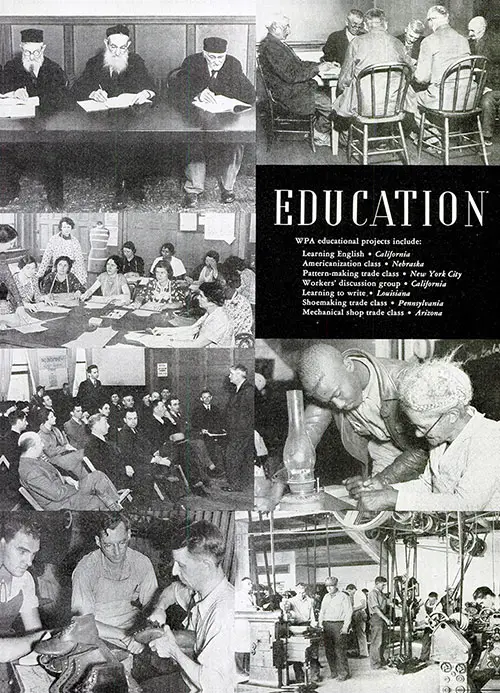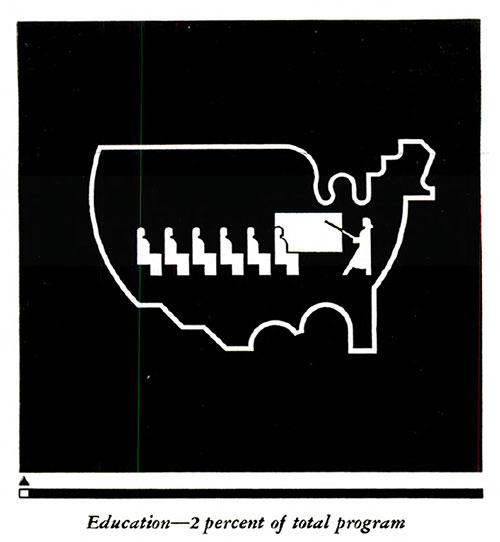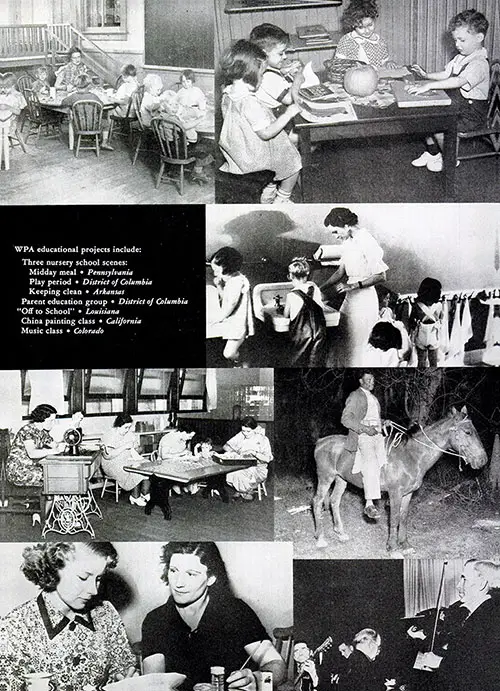📖 How the WPA Expanded Education for Adults & Children During the Great Depression
📌 This 1938 WPA report details the expansion of adult literacy programs, vocational training, and early childhood education. Learn how New Deal programs helped millions of Americans gain access to learning and job training.

Collage of WPA Educational Projects Include Learning English (California), Americanization Class (Nebraska), Pattern-Making Trade Class (New York City), Workers' Discussion Group (California), Learning to Write (Louisiana) Shoemaking Trade Class (Pennsylvania), Mechanical Shop Trade Class (Arizona). Inventory: An Appraisal of Results of the Works Progress Administration, Washington, DC: US Government Printing Office, 1938. | GGA Image ID # 1520287141
📚 WPA Educational Projects - 1938
How the WPA Transformed Education During the Great Depression
📖 This 1938 report on the Works Progress Administration (WPA) education projects highlights how the New Deal provided lifelines to unemployed teachers, illiterate adults, immigrant communities, and impoverished children. Through its adult literacy programs, vocational training, and nursery schools, the WPA expanded education to millions of Americans who otherwise had no access to learning opportunities.
For teachers, students, genealogists, and historians, this document is a goldmine of information on:
✔️ How the WPA helped the unemployed find work through education.
✔️ How literacy programs improved the lives of millions of Americans.
✔️ How vocational and workers' education reshaped American labor.
✔️ The long-term impact of WPA educational initiatives on U.S. public schooling.
📌 This report is a compelling historical resource that demonstrates how education was central to national recovery during the Great Depression.
The WPA Education program has given work in their own field of experience to tens of thousands of unemployed teachers, keeping them fit to return to non-relief jobs, and through these teachers has brought new educational opportunities to millions of citizens.

Subject Matter Index to WPA Education Projects — 2 Percent of Total Program. Inventory: An Appraisal of Results of the Works Progress Administration, Washington, DC: US Government Printing Office, 1938. | GGA Image ID # 152040a29e
In March 1938, 34,097 persons were employed on WPA educational projects throughout the country, about 95 percent of whom had been taken from local relief rolls. Under these teachers were enrolled a total of 1,542,021 persons in adult education classes, and 44,190 young children in nursery schools. In addition, 903,912 persons were attending other meetings, such as forums and lectures.
Operating through the established State agencies of education, on the principle that education is a function of the States rather than the Federal Government, the program has placed its emphasis on adult education and upon nursery schools, not only because these fields are above and below the usual range of public school service, but also because they are fields in which the depression years had brought out urgent educational needs.
The 1930 census showed that 4.3 percent of all Americans 10 years old and over are illiterate. Other studies indicate that if those are added whose knowledge is so meager that it is useless for any practical purpose, 8 to 10 percent of our people are cut off from written communication or from information through the printed word.
Such people, on the whole, have the lowest earning power and so the least consuming power. Unnecessary sickness is prevalent among them. Their children are retarded in school because of the intellectual poverty of their homes and are usually the first to leave school.
They are dangerous to a democracy, in that they are easy prey to propaganda and exploitation, and in times of depression, many of them quickly become public charges. In this field, WPA classes have enabled more than 1,000,000 illiterate American men and women to master a practical knowledge of reading and writing.
Many of the more than 200,000 persons re- ported currently in literacy classes are also candidates for citizenship, and to these the WPA teachers are offering courses designed to provide an understanding of the responsibilities, principles, and ideals of democratic government.
In November 1937, the Commissioner of Immigration and Naturalization gave official recognition to these classes by directing examiners to give consideration to certificates of their completion. But bare literacy is only the beginning of education, and many other types of adult need are being met by WPA classes and forums.
Many men and women whose schooling was cut short early in life now want to continue their education. As a result, 353,503 persons are enrolled in 25,570 classes teaching a wide variety of general subjects. More than 300,000 others are taking cultural and creative courses in order to develop constructive leisure-time interests.
The WPA education program includes "workers' education" classes and public affairs forums, to foster and increase popular under- standing of today's economic, political, and social problems which affect the welfare of all citizens.
More than 95,000 persons attend the various "public affairs" classes, and 60,000 more attend forums or other meetings. For children of low-income families, from 2 to 5 years of age, the WPA operates 1,494 nursery schools, with an enrollment of 44,190 children. Each child is given a well-balanced service covering health and nutrition, play and social development.
More than 200,000 children have benefited from these services. Education also is given to parents of the children. Women who work on WPA projects and wives and mothers who must provide for families from meager budgets which must be stretched to the limit to cover the vital necessities—133,000 of them—are being taught about foods, clothing, nutrition, health, and household management.
More than 60,000 others attend classes in child behavior and development, and family relationships. Undoubtedly the greatest contribution of the WPA in occupational training is by means of actual work on projects. But the education program has provided teachers for the training of foremen, for instruction in safety and first-aid, and for a wide variety of training in occupational skills.
Moreover, more than 200,000 persons are enrolled in 12,303 classes which offer either brush-up courses for experienced workers, or more thorough training in the less technical vocational fields.
From the standpoint of the teachers themselves, the program has enabled thousands to return to permanent non-relief jobs, not only by improving their training and enlarging their experience, but also by demonstrating the need for extension of State and local educational services, thus creating more jobs.
Lester K. Ade, Pennsylvania's State Super- intendent of Public Instruction, finds that "the demonstrated values of the service have been recognized by many public school officials, who have taken over the program as an integral part of the functions of the public schools."
Floyd I. McMurray, Indiana State Superintendent of Public Instruction, finds the pro- gram has created "a general demand that the work be permanently continued as a part of our State education." "In my judgment," says Director George D. Stoddard of the Iowa Child Welfare Research Station, "a historical perspective far removed from emergency needs will assign to the WPA well-earned credit for advancing the frontiers of American education."
Mark Starr, educational director of the Inter- national Ladies' Garment Workers' Union, adds: "The WPA education program has encouraged participation by labor unions in the study of labor problems and, in my judgment, has made a notable contribution to the elimination of social illiteracy."

Collage of WPA Educational Projects Include Three Nursery School Scenes: Midday Meal (Pennsylvania), Play Period (District of Columbia), Keeping Clean (Arkansas), Parent Education Group (District of Columbia), "Off to School" (Louisiana), China Painting Class (California), Music Class (Colorado). Inventory: An Appraisal of Results of the Works Progress Administration, Washington, DC: US Government Printing Office, 1938. | GGA Image ID # 1520406761
"Education," in Inventory: An Appraisal of Results of the Works Progress Administration, Washington, DC: US Government Printing Office, 1938, pp. 37-40.
Why This Document is Important
📜 Relevance for Different Audiences
✔ For Historians & Researchers
🔹 Documents the federal government’s role in expanding education during an economic crisis.
🔹 Examines how educational opportunities influenced social mobility.
🔹 Explores the impact of WPA programs on long-term public education policy.
✔ For Genealogists & Family Historians
🔹 Potentially links ancestors to WPA teaching jobs or educational programs.
🔹 Explores how WPA literacy and vocational classes helped immigrants and workers.
🔹 Sheds light on family members who benefited from early childhood education efforts.
✔ For Teachers & Students
🔹 Provides case studies on the role of government in education.
🔹 Illustrates how literacy, citizenship training, and vocational education shaped American society.
🔹 Demonstrates how education helped working-class and immigrant communities during the Depression.
📌 This report underscores how the WPA reshaped American education and improved access for the most vulnerable communities.
::::: Most Engaging & Insightful Content :::::
📖 Adult Literacy & Citizenship Education
✔ Why This is Fascinating:
🔹 In 1930, over 4% of Americans were completely illiterate, and up to 10% were functionally illiterate.
🔹 WPA taught over 1,000,000 adults how to read and write.
🔹 Special programs helped immigrants learn English and prepare for U.S. citizenship.
🔹 Naturalization officials recognized WPA literacy certificates in citizenship applications.
✔ Key Takeaway:
The WPA helped transform adult education and provided a pathway for many to become literate, engaged citizens.
📌 This section highlights how the WPA used education as a tool for social and economic empowerment.
👩🏫 Providing Jobs for Unemployed Teachers
✔ Why This is Fascinating:
🔹 Tens of thousands of unemployed teachers were put back to work.
🔹 Many had lost their jobs due to school funding cuts during the Depression.
🔹 The WPA allowed teachers to work in their field instead of switching to manual labor.
🔹 95% of WPA education workers came from local relief rolls.
✔ Key Takeaway:
The WPA not only preserved educational jobs but also ensured teachers remained in their profession.
📌 This section connects job creation to the survival of the teaching profession during the Great Depression.
🏭 Vocational Training & Workers' Education
✔ Why This is Fascinating:
🔹 Over 200,000 people enrolled in WPA vocational training courses.
🔹 Trade classes included shoemaking, mechanics, pattern-making, and other essential skills.
🔹 Workers’ education programs taught employees about economic and labor issues.
🔹 Unions and industry groups supported WPA worker training programs.
✔ Key Takeaway:
The WPA provided a direct link between education and workforce development, helping workers gain practical skills.
📌 This section showcases how the WPA addressed unemployment through hands-on job training.
🧒 Nursery Schools & Parent Education
✔ Why This is Fascinating:
🔹 WPA operated 1,494 nursery schools with over 44,000 children enrolled.
🔹 More than 200,000 children benefited from early childhood education and health programs.
🔹 Parents received training in child behavior, nutrition, and family management.
🔹 Children from impoverished families were given meals, playtime, and structured education.
✔ Key Takeaway:
The WPA pioneered early childhood education, a concept that later influenced Head Start and public preschool programs.
📌 This section highlights how WPA programs laid the foundation for modern early childhood education.
🖼 Noteworthy Images & Their Significance
🖼 📚 "Collage of WPA Educational Projects"
🔹 Showcases adult literacy classes, trade schools, and Americanization programs.
🔹 Demonstrates how the WPA targeted education for diverse populations.
🖼 📊 "WPA Subject Matter Index - Education"
🔹 Reveals that education made up 2% of all WPA projects, showing its importance within the New Deal.
🖼 🎓 "Collage of Nursery Schools & Parent Education"
🔹 Displays how the WPA provided structured learning and meals for young children.
🔹 Highlights parent education programs that taught nutrition and child development.
📌 These images provide a powerful visual representation of the WPA’s role in shaping American education.
Bias & Perspective Considerations
✔ Pro-WPA Narrative:
🔹 The report emphasizes success stories but does not address criticisms, such as:
🔹 Were all teachers and students treated equally?
🔹 Were WPA classes accessible to all racial and ethnic groups?
🔹 Were these programs sustainable beyond WPA funding?
✔ Lack of Discussion on Funding & Long-Term Impact:
🔹 The document does not address the financial costs or whether states continued the programs after WPA funding ended.
✔ Limited Mention of Opposition:
🔹 Some communities and private schools opposed federally-funded education programs, yet this is not mentioned in the report.
📌 While this document provides a valuable perspective on WPA education, further research is needed for a complete historical picture.
Final Thoughts: Why This Report Matters
"WPA Educational Projects - 1938" is a fascinating account of how federal intervention helped expand education during the Great Depression. By providing jobs for teachers, literacy programs for adults, vocational training, and nursery schools for children, the WPA transformed American education and helped millions of citizens improve their lives.
📌 Many of these initiatives—like public preschool programs, adult literacy education, and workforce training—continue to shape modern education policies today.
📚 The legacy of these programs proves that education is a powerful tool for economic recovery and social progress! 🎓👏
